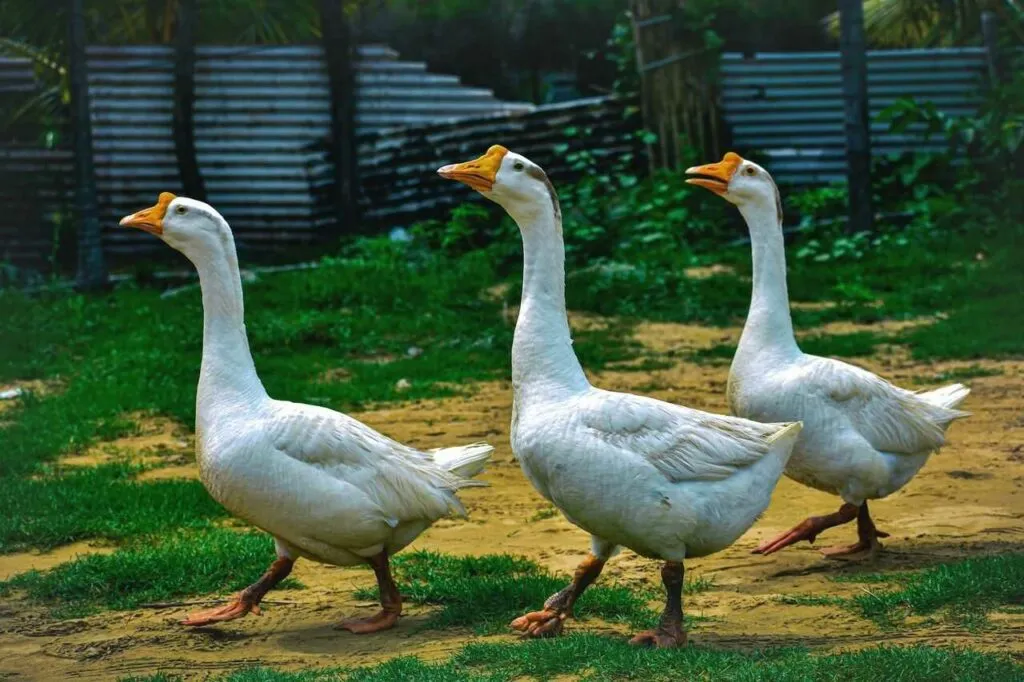
Domestic Goose
Domestic Goose
Domestic Goose
The 'Domestic Goose' is a bird you might have often heard about. While it is primarily kept as a domestic bird, not many may know what exactly a goose is. Let us introduce you to the fascinating world of the domestic goose.
Domestic Goose Basic Infomation

Order: Anseriformes, Family: Anatidae, Subfamily: Anserinae, Genus: Anser
Body length: 50 to 120 cm
Weight: 4 to 15 kg
Geese were originally domesticated from wild 'geese', making them domestic birds found across Europe, China, Africa, and Japan. They are known worldwide for living with humans.
Their bodies are generally white, and their bills and legs are orange. They have long necks, and their eyesight is so keen that they can see well even at night. Their bills are conical in shape, which makes their face look cute with a triangular shape when viewed from the side.
However, these characteristics are typical of general geese, and depending on the species, the color of the body may vary, and some may have knobs on their bills.
As waterfowl, they have spikes in their bills that are convenient for picking up food in the water. The spikes filter out water, allowing them to consume only the food.
Geese are birds but cannot fly as other birds can because they are heavy and their wings are not suited for flying. They usually walk around, which also looks quite adorable.
Domestic Goose Q&A

What is the origin of the name 'Domestic Goose'?
The name 'Domestic Goose' is written in kanji as '鵞鳥'. It has been called 'Goose' since the Edo period, but previously it was represented by the character '鵝', pronounced as 'ga', reflecting the sound they make. The sound 'gaga' led to the combination of characters for 'I' and 'bird' to form '鵝'. The name evolved from these representations, but today '鵞鳥' and '鵝' both refer to the goose, indicating the origin is related to the sound of its call.

What does the goose eat?
Geese eat corn, soy, and bran, but their favorite food is grass. When kept in fields, they can help by eating weeds, which benefits both the geese, who get their favorite food, and humans, who have less weeding to do. This mutually beneficial relationship helps in maintaining a good environment for both.

How do geese reproduce?
Geese begin laying eggs in the spring. They can lay about 20 eggs per year, and in some species, the number can reach 40-50. While some of the eggs are naturally incubated by the geese, humans often take over the incubation process. After about a month of incubation, goslings are born, and although they are not raised by their parents in captivity, humans take over their care. Geese grow slowly and take about two years to fully mature.

Is the goose a pet?
While geese are not typically kept as pets like dogs or cats, they live with humans as domesticated farm animals. They also serve a role similar to working animals. Geese can form strong bonds with humans and are known to act as guards, alerting their owners to strangers or potential threats by honking and chasing away intruders. This protective behavior has been employed in various settings, including guarding distilleries in Scotland, where they are known as 'Scotch Watch'. Geese were chosen for their vigilance and ability to work as effective security guards.

Are geese consumed?
As domesticated animals, geese are raised for various purposes, including their meat. In many parts of the world, goose meat is a traditional food, particularly famous for being used to make foie gras, a delicacy. Besides meat, goose feathers are also highly valued, especially in making high-quality down for bedding and clothing. While not commonly eaten in Japan, geese contribute to human life in many ways, from providing food to contributing to agricultural practices.

Do geese appear in folklore?
Geese have been a part of human culture and folklore for thousands of years, appearing in various myths, stories, and idioms. They are often symbolized as creatures of vigilance and fidelity. One famous European story involves a goose that laid golden eggs, symbolizing wealth and greed. The story serves as a moral lesson about greed and patience, illustrating the cultural significance of geese beyond their physical attributes or economic benefits.

Would you like to become a part of the 'Animalbook.jp'?
Turn your knowledge into Q&A and share it with the world. ※Publication will be activated after purchase. Let's share information together!
Domestic Goose Type of List

- Domestic Goose
- Red-footed Goose
- Bean Goose
- Grey Goose
- Emperor Goose
- Sakhalin Goose
- Lesser White-fronted Goose
- Indian Goose
- Snow Goose
- Taiga Bean Goose
- Ross's Goose
- Tundra Bean Goose
Information
Congratulations! You are the first commenter!

Create Your Favorite List!
Domestic Goose
Save the animals you love! Build your own list to quickly revisit your favorites later.

Would you like to leave a comment?
※Please note: This is for the purchase of rights to post comments within the article.
Find Your Favorites!
Our shop offers a unique and attractive selection of goods themed around various animals.
Domestic Goose References

- Wikipedia ガチョウ https://ja.wikipedia.org/wiki/ガチョウ
- Wikipedia マガン属 https://ja.wikipedia.org/wiki/マガン属
- Wikipedia ガチョウと黄金の卵 https://ja.wikipedia.org/wiki/ガチョウと黄金の卵
- weblio辞書 https://www.weblio.jp/content/ガチョウ#:~:text=ガンを飼いならし,や愛玩用とする。
- 1分で読める!![違いは?]モノ・コトの違いを1分で解説!! https://lowch.com/archives/14101
- 畜産ZOO鑑 http://zookan.lin.gr.jp/kototen/gakko/gacho1.html
- コトバンク https://kotobank.jp/word/ガチョウ-763155
- Study-Z ドラゴン桜と学ぶ学習メディア https://study-z.net/100185870/2
- スッキリ 言葉の疑問を解決するサイト https://gimon-sukkiri.jp/duck-goose/
- ピクシブ百科事典 https://dic.pixiv.net/a/ガチョウ
- 語源由来辞典 https://gogen-yurai.jp/gatyou/#:~:text=ガチョウの語源・由来&text=「鵝」は「ガガ」,「ガチョウ」となった。
- SUNTORY The Scotch https://www.suntory.co.jp/whisky/Ballantine/chp-12.html
Domestic Goose Introduction of media used
出典:https://www.pexels.com/ja-jp/video/856908/

出典:https://unsplash.com/ja/写真/-ZDjkXtYeCI

出典:https://unsplash.com/ja/写真/iSg8kutQCco

出典:https://pixabay.com/images/id-3568536/

出典:https://pixabay.com/images/id-7807430/

出典:https://pixabay.com/images/id-4164615/

出典:https://unsplash.com/ja/写真/IWnuBhG_y34

other
出典:https://pixabay.com/images/id-1109605/

出典:https://pixabay.com/images/id-7816262/

出典:https://pixabay.com/images/id-6880917/

Help Enrich Our Animalbook.jp with Your Media!
We are constantly looking to expand and enrich our Animalbook.jp with amazing photos and videos of animals. If you have any media that you'd like to share, please contribute and help us showcase the beauty and diversity of the animal kingdom. Your submissions will be credited and featured in our encyclopedia, reaching a wide audience of animal lovers.


















